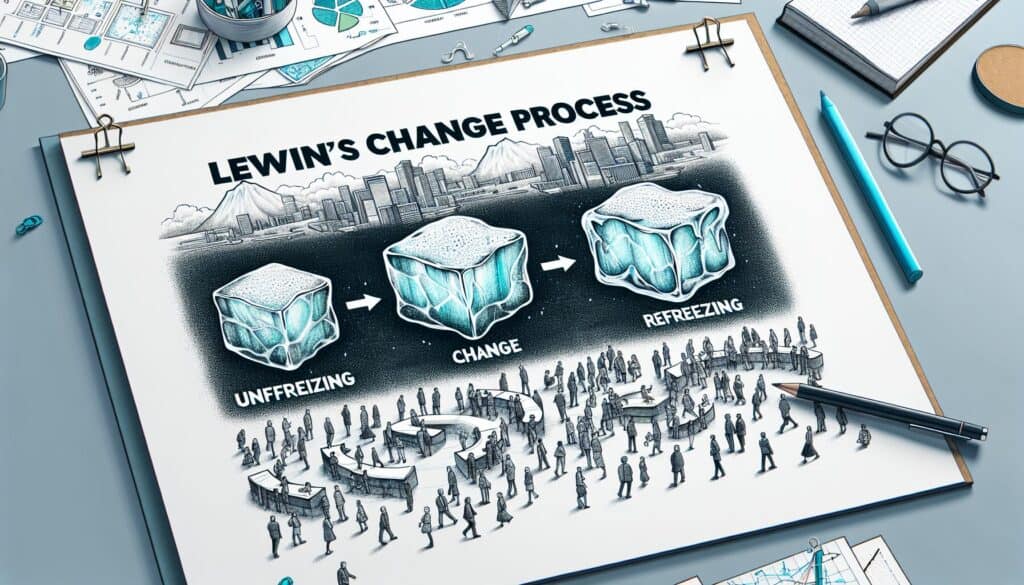To provide a framework for managing organizational change.
- Methodologies: Project Management
Lewin’s 3-stage Change Process

Lewin’s 3-stage Change Process
- Agile Methodology, Change Management, Continuous Improvement, Design Thinking, Lean Manufacturing, Organizational Transformation, Process Improvement, Project Management, Quality Management
Objective:
How it’s used:
- A model that describes change as a three-stage process: Unfreezing (preparing for change), Changing (implementing the change), and Refreezing (stabilizing the change and making it permanent).
Pros
- Simple and easy to understand; Provides a clear roadmap for change; Emphasizes the importance of preparing people for change and reinforcing it.
Cons
- Can be too simplistic for complex or rapid changes; Assumes a linear process, which may not always be the case; Does not offer detailed guidance on how to manage resistance or specific change tactics.
Categories:
- Human Resources, Project Management
Best for:
- Guiding organizations through planned changes by providing a structured, step-by-step approach.
In the realm of product design, innovation, science, and engineering, Lewin’s 3-stage Change Process can significantly support organizations in adapting to new market demands or technological advancements. This methodology finds application across various industries, including technology, healthcare, and manufacturing, where systematic change is frequent and necessary. For instance, during the development of advanced medical devices, the Unfreezing stage might involve gathering stakeholder feedback to identify existing limitations in current products and preparing teams for new regulatory standards. In the Changing phase, cross-functional teams might implement agile methodologies to accelerate prototyping and testing processes, ensuring rapid iterations that reflect user needs. The Refreezing stage would then involve embedding new processes and practices by training staff and establishing quality control measures to solidify these changes. Typically, change initiatives are championed by project managers, team leaders, or executives who possess a vision for innovation and foster collaboration among team members. Communication is critical throughout all stages, ensuring everyone is aware of their role and the goals of the changes, thus reducing resistance and encouraging acceptance. As a structured approach, Lewin’s model provides a clear and concise framework, enabling organizations to visualize transitions and maintain momentum to effectuate lasting improvements in performance and product quality.
Key steps of this methodology
- Identify and communicate the need for change to stakeholders.
- Challenge existing beliefs and behaviors that resist change.
- Facilitate training and support for employees during the transition.
- Implement the change initiative with clear actions and timelines.
- Monitor the change process and make necessary adjustments.
- Reinforce new behaviors and practices through incentives.
- Establish systems and processes to sustain the change long-term.
Pro Tips
- Invest in change champions within the organization to facilitate communication and reduce resistance during all three stages.
- Utilize data analytics to assess the impact of the change during the Changing phase, allowing for real-time adjustments and feedback loops.
- Develop a reinforcement plan in the Refreezing phase that includes continuous training and recognition programs to sustain the change long-term.
To read and compare several methodologies, we recommend the
> Extensive Methodologies Repository <
together with the 400+ other methodologies.
Your comments on this methodology or additional info are welcome on the comment section below ↓ , so as any engineering-related ideas or links.
Historical Context
1962
1970
1972
1980
1980
1986
1986
1960
1963
1970
1980
1980
1980
1986
1987
(if date is unknown or not relevant, e.g. "fluid mechanics", a rounded estimation of its notable emergence is provided)















Related Posts
Musculoskeletal Discomfort Questionnaires
Multivariate Testing (MVT)
Multiple Regression Analysis
Motion Capture Systems
MoSCoW Method
Mood’s Median Test